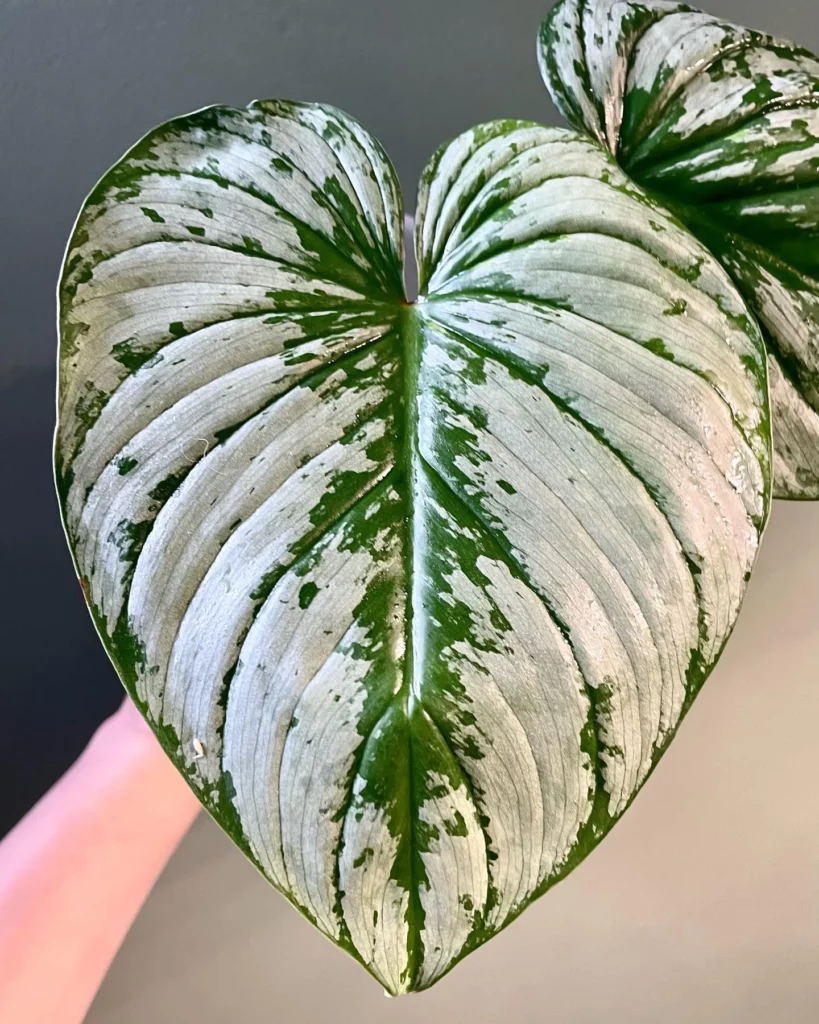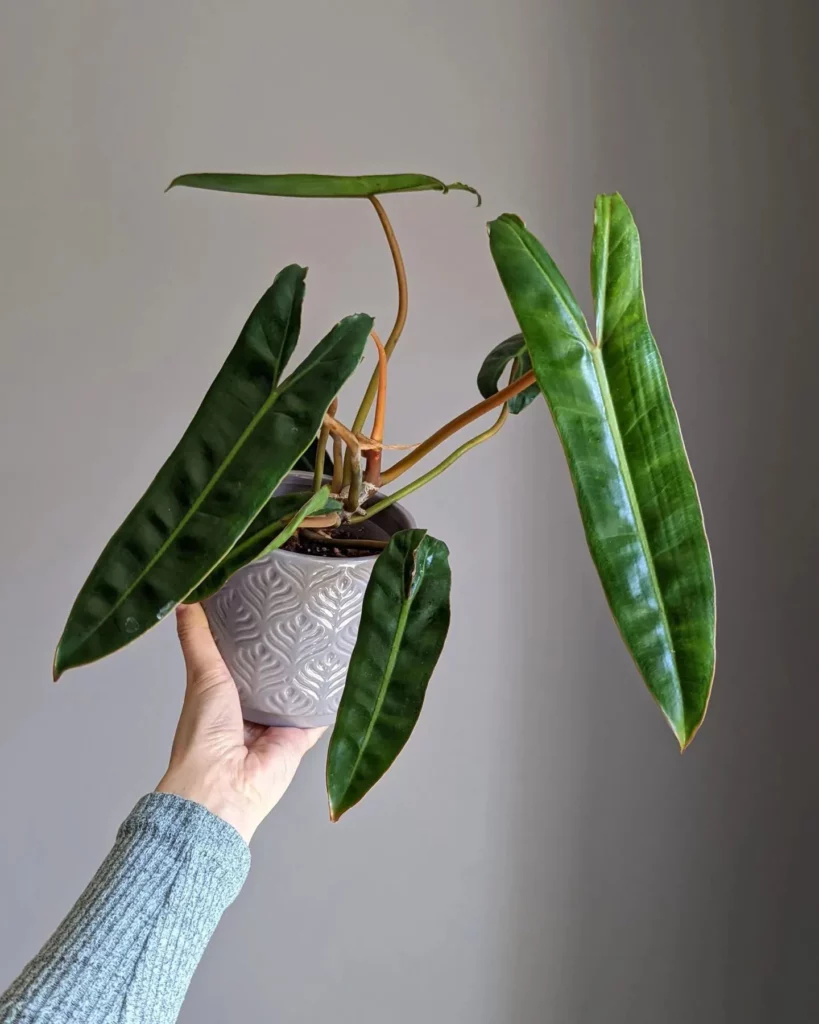Welcome to our care guide for the Philodendron Narrow, also known as Philodendron angustisectum. This popular indoor plant offers a unique and exotic look with its long, narrow green leaves that have heavily serrated edges. Native to South America, the Philodendron Narrow is a low-maintenance plant that thrives in warm and moist conditions. Whether you’re a seasoned plant enthusiast or a beginner, caring for your Philodendron Narrow is easy with these simple tips.
Key Takeaways:
- Philodendron Narrow, or Philodendron angustisectum, is an easy-to-grow indoor plant with distinctively long, narrow, green leaves.
- This plant can tolerate both bright and lower lighting conditions, making it versatile for different indoor environments.
- Take care to keep the Philodendron Narrow away from pets and children, as it is considered poisonous.
- Proper watering, fertilizing, and providing adequate light are essential for the health and longevity of your Philodendron Narrow.
Appearance of Philodendron Narrow



The Philodendron Narrow is admired for its beautiful and distinct appearance. It features long, narrow leaves that are green in color. The edges of the leaves are heavily serrated, giving them a unique and eye-catching look. These characteristics contribute to the plant’s tropical and jungle-like vibe, making it a popular choice among indoor plant enthusiasts.
Light Requirements for Philodendron Narrow



The Philodendron Narrow, also known as Philodendron angustisectum, is a versatile plant when it comes to light requirements. While it thrives in bright, indirect light, it can also tolerate lower lighting conditions. To ensure its optimal growth, it is best to place the plant in a location where it can receive medium to bright filtered light throughout the day.
When positioning your Philodendron Narrow, avoid exposing it to too much direct sunlight as it can lead to washed out foliage and brown patches on the leaves. Monitoring the light exposure and adjusting accordingly will help maintain its vibrant and healthy appearance.
Watering Philodendron Narrow



Proper watering is essential for the health and vitality of your Philodendron Narrow. This beautiful plant prefers its soil to stay barely moist. While it can tolerate some drought, it’s important to avoid prolonged exposure to dry soil, as it can result in brown and crisp edges on the leaves.
Regular watering is key to maintaining the optimal moisture level for your Philodendron Narrow. Check the soil frequently to assess its dryness. If the soil feels dry to the touch, it’s time to water your plant. Ensure that you water thoroughly, allowing the water to evenly distribute throughout the soil.
To prevent overwatering and potential root rot, it’s crucial to provide proper drainage. Make sure the container or pot has drainage holes to allow excess water to escape. This helps maintain the right balance of moisture in the soil and prevents waterlogged conditions that can lead to yellowing leaves and drooping.
Establish a watering schedule that aligns with your Philodendron Narrow’s needs. Factors such as the size of the pot, the lighting conditions, and the temperature in your home can influence the frequency of watering. As a general guideline, aim to water your Philodendron Narrow every 1-2 weeks, or when the top inch of the soil feels dry to the touch.
Fertilizing Philodendron Narrow



Proper fertilization is essential for the healthy growth and development of your Philodendron Narrow. It is recommended to use a well-balanced organic fertilizer to provide the necessary nutrients. Fertilizing once a month during the growing season will ensure that your plant receives the right amount of nourishment.
When selecting a fertilizer, look for one that is specifically formulated for houseplants and contains a balanced ratio of nitrogen, phosphorus, and potassium (NPK). This will provide your Philodendron Narrow with the nutrients it needs to thrive.
During the winter months when the plant is in a dormant phase, it is best to refrain from fertilizing. This allows the plant to rest and prepare for new growth in the spring.
When applying the fertilizer, follow the instructions provided by the manufacturer. It is important not to over-fertilize, as this can lead to nutrient burn and damage the plant’s roots. Always dilute the fertilizer according to the recommended dosage and apply it to the soil around the base of the plant.
Potting Philodendron Narrow



Proper potting is essential for the health and growth of your Philodendron Narrow. To ensure optimal conditions, it is recommended to use a well-draining, moisture retentive organic potting mix. This type of soil allows for proper water drainage, preventing root rot, while also retaining enough moisture to keep the plant hydrated.
If your Philodendron Narrow becomes pot-bound or top-heavy, it is a good idea to repot it into a slightly larger container with good drainage. This will give the roots more room to grow and prevent the plant from becoming root-bound. When repotting, be sure to use an organically rich potting mix to provide the necessary nutrients for healthy growth.
Propagation of Philodendron Narrow



To propagate Philodendron Narrow, you can use stem cuttings. Start by cutting a section of the plant’s stem, approximately 7.5 centimeters below a leaf joint. Make sure to remove the lower leaves near the cut. Place the cutting in a container filled with water and keep it in a filtered bright light position. Roots will start to develop, and they will be around 10 centimeters in length. Once the roots have formed, you can plant the cutting in a small pot filled with well-draining potting soil. Keep the soil moist until the cutting has established itself and produced new leaves. For optimal success, it’s recommended to take cuttings during the plant’s growing season.
Growth and Development of Philodendron Narrow



The Philodendron Narrow, with its average height of 60-90 centimeters, is a plant that flourishes when grown indoors. This tropical beauty requires medium to bright light conditions to promote its growth and development. To ensure a healthy and robust Philodendron Narrow, it is important to provide it with the necessary light it craves.
If you notice that the leaves are deep green or small in size, it may indicate a lack of light. In such cases, consider relocating the plant to a brighter spot to encourage optimal growth. By creating the ideal lighting environment and following proper care practices, you can enjoy the full splendor of the Philodendron Narrow in your home.
Pests and Diseases of Philodendron Narrow


Although Philodendron Narrow is generally resistant to pests, it can be vulnerable to infestations when faced with stress. Common indoor plant pests like mealybugs, scale, and spider mites can weaken the plant and cause issues such as excessive yellowing fronds and leaf drop. To maintain the health of your Philodendron Narrow, it is crucial to keep a close eye on the plant for any signs of pest infestation and take appropriate measures to address them.
An effective way to combat these pests is by using organic pesticides. These natural alternatives are safer for both you and your plant. Besides pest control, it’s also essential to identify and address any environmental stressors that may be compromising the plant’s health. Creating a hospitable environment for your Philodendron Narrow will help protect it from pests and diseases, ensuring its longevity and vibrancy.
Conclusion
The Philodendron Narrow is an excellent choice for any indoor plant enthusiast. Its long, narrow, and heavily serrated leaves give it an exotic appearance that will add a touch of tropical beauty to your home. The best part? This plant is incredibly low maintenance, making it perfect for both experienced and novice plant owners.
One of the key advantages of the Philodendron Narrow is its ability to thrive in various lighting conditions. Whether you have a bright, sunny spot or a dimly lit corner, this plant can adapt and flourish. Just be sure to avoid direct sunlight, as it can damage the foliage.
When it comes to caring for your Philodendron Narrow, remember to water it regularly, keeping the soil barely moist. Fertilize it once a month during the growing season, and make sure to use a well-draining, moisture retentive organic potting mix. Additionally, keep an eye out for any potential pest infestations and address them promptly using organic pesticides if necessary.
FAQ
What is the appearance of Philodendron Narrow?
Philodendron Narrow has long, narrow leaves that are green in color. The edges of the leaves are heavily serrated, giving it a unique and exotic appearance.
What are the light requirements for Philodendron Narrow?
Philodendron Narrow thrives in bright, indirect light. It can also tolerate lower lighting conditions, making it suitable for areas with less natural light.
How should I water Philodendron Narrow?
Philodendron Narrow prefers its soil to stay barely moist. It’s important to water the plant on a regular basis, checking the soil often to see how dry it is. Avoid prolonged exposure to dry soil.
How often should I fertilize Philodendron Narrow?
It is recommended to fertilize Philodendron Narrow once a month during the growing season with a well-balanced organic fertilizer.
What type of soil should I use for potting Philodendron Narrow?
Philodendron Narrow should be potted in a well-draining, moisture-retentive organic potting mix to allow for proper water drainage and sufficient moisture for the plant’s roots.
How can I propagate Philodendron Narrow?
Philodendron Narrow can be propagated through stem cuttings. Cut a section of the plant’s stem below a leaf joint, remove lower leaves, place the cutting in water until roots develop, then transfer to a small pot with well-draining potting soil.
How tall does Philodendron Narrow grow indoors?
Philodendron Narrow has an average height of 60-90 centimeters when grown indoors.
How can I protect Philodendron Narrow from pests and diseases?
While Philodendron Narrow is generally resistant to pests, it can become susceptible to infestations when under stress. Monitor the plant for any signs of pest infestation and treat them with organic pesticide if necessary.
Is Philodendron Narrow a low-maintenance plant?
Yes, Philodendron Narrow is a low-maintenance plant. It is easy to care for and offers an exotic appearance without requiring much effort.




